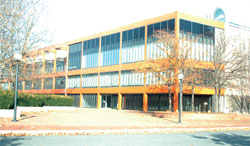An historic neighborhood named for three streets that intersect to create a busy commercial district has seen highlights and lowlights over the past 50 years, but one organization is poised to shed new light on the X, through collaborative, arts-centered initiatives.
Springfield residents: try giving someone from out of town directions to Forest Park without using the term ‘the X.’
It’s not easy.
The historic landmark, which typically refers to the intersection of Sumner Ave., Dickinson, and Belmont streets and the surrounding area, has long been a center of commercial activity in Springfield and something of a source of pride for locals. We know why it has its distinctive name. We know to look both ways – twice – when driving through.
But there is a group of people who want the X to mean much more.
The X Main Street Corp., named as such due to its involvement in the federal ‘Main Street’ program for commercial district improvement and consisting of residents, business owners, and civic leaders, want the X to live up to its hip name, and are working to create a new hot spot in Western Mass.
The X, specifically, is a commercial district within the Forest Park neighborhood of Springfield, which some call a city within a city, due to its rich history, diverse ethnic and economic make-up, and its distinction as home to 25,000 of Springfield’s residents. But in the past, it has been known more for its flavor than its demographics.
Lyn Nolan, executive director of the X Main Street Corp., remembers a time when the area was bustling with shoppers, and the shops and restaurants were as unique as they were prosperous.
“Blake’s department store was a hub of activity,” she said, harkening back to her first year as a Springfield resident in 1980. “And there were specialty clothing stores, fantastic restaurants, a movie house where the Walgreens is now … it was definitely a ‘Northampton kind of place.’”
Even today, she continued, the X includes some of the city’s brightest gems – distinctive restaurants, unique clothiers, and a smattering of successful niche businesses.
It’s also home to a number of popular seasonal events, including the Farmer’s Market at the X, now entering its ninth year, and the annual Boar’s Head Festival, a medieval fair of sorts held at Trinity United Methodist Church. And year-round, several community organizations based at the X and within Forest Park work toward a number of goals, all aimed at bettering the neighborhood.
In addition to the non-profit X Main Street Corp., the Forest Park Partnership and Forest Park Civic Association are also active, as are neighborhood councils such as the La Broad and Avalon councils, centered on quality of life and crime-reduction issues, and the for-profit Concerned Citizens for Springfield, which focuses much of its time in the Forest Park neighborhood.
Still, the spark that once defined a crossroads has dimmed somewhat, now lacking many of those one-of-a-kind storefronts and the neighborly feel that Nolan remembers.
“There was some flight in terms of residents,” she said, “and malls happened. That had a huge impact on the commercial success of many small businesses that once thrived here.”
The X Main Street Corp. has been focused on re-lighting the fire at the X for the past decade. But one overriding theme has emerged within all of the X Main Street Corp.’s initiatives for 2006, which its members hope will help fan the flames: the creation and promotion of a cohesive arts and entertainment-based culture at the X – one that starts internally with X Main Street’s own efforts, and extends to other groups, residents, and, most importantly, other businesses.
They’ve Made a FoPa
The overall mission of the corporation, Nolan said, is to spearhead ongoing development projects within the X commercial district, and to promote those improvements in partnership with other community organizations and businesses in the Forest Park area.
“There is a lot of overlap between the different groups,” she said. “Some people work with all of them. We work with each other, not against.”
The renewed focus on arts and culture is one she also hopes will resonate within those other organizations, as one answer to many issues ranging from decreasing home ownership to lagging interest in commercial real estate.
Although Nolan said the commercial landscape at the X has seen some improvement in the past few years, and is showing signs of a continued climb, the business make-up has changed somewhat since its heyday.
“Economic development in the X commercial district is stable,” Nolan said. “We’re at a 92% capacity in the area. But, for example, we have four dollar stores. We definitely need some diversification.”
Essentially, the X Main Street Corp. hopes to cultivate a climate at the X that will ripple throughout its parent neighborhood of Forest Park. There’s business sense to it, Nolan said – the arts have been proven in other communities, including neighboring Northampton and Amherst, to serve as effective economic drivers – but there are also some intriguing marketing opportunities to be had.
Brian Hale, vice president of the X Main Street Corp. Board of Directors and Chair of the Bing Arts Center Committee (more on that later), said working toward a stronger arts and entertainment scene at the X could start with creating a buzz – a move that, among other things, is more economical than most.
“The X is the hub of Forest Park,” he said. “Or, as we’d like to start calling it, FoPa.”
Borrowed from similar nicknames such as New York’s Soho (‘south of Houston street’) neighborhood, or, more regionally, Noho, the abbreviation often given to Northampton, ‘FoPa’ is a small, simple way to start branding the neighborhood as well as its cultural attributes.
And the play on words isn’t an accident.
“A booming arts community in Springfield? Some might call the suggestion a faux pas,” Hale joked. “If there’s one thing we’ve learned as Springfield residents, it’s that you have to have a sense of humor.”
It’s important to note, though, that the X Main Street Corp. doesn’t just brainstorm catchy nicknames for the neighborhood. Rather, the organization is actively involved with a number of real estate improvement ventures, serves as an advocacy group for zoning, legislative, and public safety policies, and is one of the X’s primary grant-writing entities, forever in search of funds to keep various projects and business ventures going. The corporation is partially funded by a Housing and Urban Development (HUD) grant, but gleans much of its funding from local, state, and national grants and loans.
The organization also works with the city to enforce some code regulations at the X, which is designated an overlay district (a zoning change X Main Street kick-started), and as such, requires businesses to meet or exceed certain aesthetic requirements.
Signage must meet a certain quality threshold, for instance – backlit plastic signs are prohibited as are unframed, aluminum placards.
That aspect of the corporation’s duties can both help and hinder its relationship with X merchants, Nolan said. It allows for greater contact with businesses, but can also turn X Main Street into the “sign police.”
“We don’t want all the businesses to look the same,” she said, “but we want to achieve a certain level of quality, a certain look. The main goal of X Main Street is to increase arts and culture in the X commercial district, and the look of the businesses is one part of that. It’s what will make the most sense in terms of diversifying the area and bringing in more great businesses as well as visitors.”
Bought-A-Bing
As another part of that focus, the corporation soon hopes to make its new headquarters the historic Bing Theatre, which it purchased in 2003. The property, now known as the Bing Arts Center, has been vacant for years but is seeing some new activity: the X Main Street Corporation and the Bing Arts Center Committee, a group of concerned citizens and business owners committed to arts, culture, and entertainment endeavors in Springfield, are in the process of renovating the building to create a combination art gallery, community center, and, eventually, a movie theater and performance venue.
Hale said re-opening the cinema itself represents the last step in a long process, but he hopes to see the other components of the arts center fall into place within the next two years.
“The Bing represents exactly what we want to see more of at the X, in Forest Park, and across the city, and that is investing in the arts and culture as a primary economic driver,” he said, adding that he sees arts, culture, and entertainment investments as the logical choice in a city that is still struggling in most other sectors and is in dire need of some good news.
“Frankly, I think it’s the city’s only choice. Historically, Springfield has been a manufacturing center, but that’s long gone,” he told BusinessWest. “We need to face that, and work to get people into this city to spend their money, plain and simple. How do we do that? By having some cool things going on.”
The Bing actually sits on the periphery of the X, but Nolan agreed with Hale that it represents the heart and soul of the organization’s work.
“Creating an arts center at the Bing is a perfect example of how the arts can serve as a way to engage the entire community,” she said. “We want to see things going on constantly in that building, creating a buzz and at the same time opening up the arts to a whole new audience.”
Hale added that it’s important to sell that point, especially to X merchants, many of whom are struggling to make their ventures work.
“The arts might be one of the only economic drivers in which we can say you can put a little in, and gain a lot,” he said. “At the Bing Arts Center we’ll be able to hold art shows and performances, after school programs, fundraisers, sell artwork … the possibilities are endless. Merchants can do much of the same on many levels, and we want to work with them to increase their own profits for the overall good of the area.”
Blue Moon Coffee Roasters, Hale offered as an example, has already seen some success with just such an initiative. Located across the street from the Bing, the coffee, bean, and gift shop expanded its retail component recently to include an art glass gallery, and in December, owner Dan Higgins reported that sales of the artwork represented 30% of his total receipts.
“We need to reach a certain critical mass before people are going to notice this,” said Hale, “but we can start by marketing ourselves as an arts-oriented neighborhood, and a big part of the neighborhood is the businesses at the X.”
Turnip Turn-out
But it’s not just the Bing that’s getting attention from X Main Street, and the other organizations at the X and in Forest Park. The annual Farmers’ Market at the X, a Forest Park staple for nearly a decade, will be expanding its scope in 2006, welcoming artisans to the ranks of fresh produce, meat, whole foods, plant, and flower businesses, in order to add a new dimension to the event as well as a venue for artists and craftspeople.
“We want to work closely with artisans to give them a unique venue to show their work, but we’re also trying to move with the times,” Nolan explained, adding that the event is also moving from its spot near the Goodwill Shoppes to the Trinity church parking lot, visible from Sumner Ave. “Farmers’ markets in general are starting to suffer in New England – in the past, they were held specifically for farmers.”
But with a changing landscape must come a change in the event, she said.
“Adding arts and crafts to the market will add to the overall arts and culture thrust in the X commercial district, and give the market a shot in the arm.”
It’s also another way to capitalize on an already well-known event at the X for the benefit of local businesses.
Belle Rita Novak, manager of the Farmers’ Market at the X and a member of the Forest Park Civic Association and the X Main Street Corp. Board of Directors, said she has already seen the positive effect the market can have on surrounding merchants.
“Many patrons shop at the X while they are in the area for the market,” she said. “Throughout the country, farmers’ markets in urban areas are economic engines for the businesses nearby.”
Novak added that increased cooperation with X business owners would likely create a positive ripple effect in the district.
“I think that we have a strong X Main Street board now, but we need more input from the business and property owners at the X,” she said. “After all, if the X improves, it benefits everyone, including residents in the neighborhood.
“The X looks much better than it did 10 years ago,” she continued, “but if it doesn’t continue to improve I fear that it could backslide very easily. We are in this together, merchants, property owners, and residents. If we want a nice, clean business district then we all have to do our part.”
New Direction Home
Hale agreed with Novak that continued partnerships are the keys to spurring further arts-related initiatives, as well as projects aimed at the overall health of the commercial district.
“In order to revitalize any commercial district, there needs to be a certain camaraderie,” he said. “We can’t just start walking into stores and asking for money. We need to sell them on the arts and culture premise, and show them how it can benefit their businesses … and in turn, their businesses will benefit the entire area.”
And the members of the X Main Street Corp. will be keeping an ear close to the ground, listening for the sound of success – someone asking for directions to FoPa.
It’s easy to find – just start at the X.
Jaclyn Stevenson can be reached at[email protected]













































